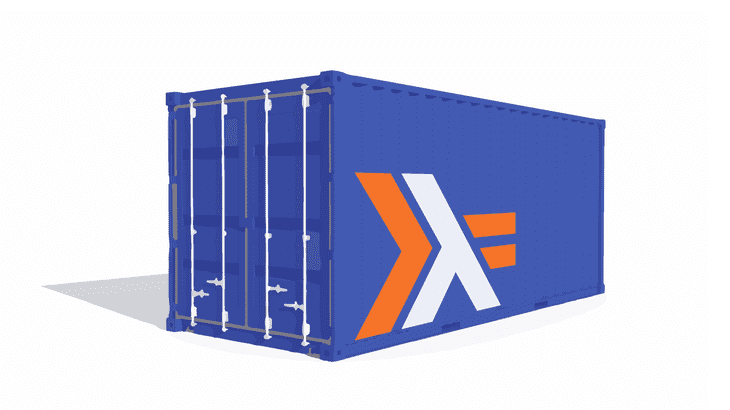At my current job, we are starting to adopt Haskell to write some of our backend APIs and, like other projects at the company, we are using Docker for deploying them to staging and production environments.
Working with Haskell required some re-thinking on how we do certain parts of our workflow, but it also led to a much improved image size, with some extra room for improvement.
Unlike PHP or JavaScript, Haskell is a compiled language, meaning that some of previous approaches we were using for building Docker images did not port that well.
For dynamic languages, we followed roughly these steps to build our images:
- Use a base image with packages for the software we need (Debian, Alpine).
- Install server software, such as Nginx, Node.js, and PHP.
- Install language tools and package managers.
- Copy application sources.
- Download dependencies.
- Final optimizations and cleanup.
This is a hybrid approach where we have both build and runtime dependencies on the same Docker image, which is useful because image builders such as Quay.io can automatically build the docker image for you on every commit without the need of an additional step in the CI pipeline, and this also has the slight advantage of having enough tooling inside a container for light debugging.
As a result, the image size is not the smallest it could be since there is a lot of things that are not commonly used during runtime. However, the added convenience sort of out weighs the issues of having a larger image for these cases.
For Haskell projects, though, things are bit different, and not in a bad way:
The community has made an excellent build tool called Stack. stack takes
care of mostly everything related to setting up your project: Installing GHC,
pulling dependencies, building, testing, coverage reports, documentation. When
paired with Nix, it can even pull non-Haskell dependencies for reproducible
builds.
If we try to do a hybrid image approach like above using Stack, we mainly have to do the following on a Dockerfile:
- Download and install Stack.
- Copy application sources.
- Install GHC (
stack setup). - Compile project (
stack build).
This works, but it is extremely slow and the resulting images are huge (+800MB!).
On every Docker build, stack would have to download and install GHC, and then
proceed to download and compile every dependency of the project, which tended
to a good 30 minutes on a Quay.io worker node.
When developing locally, you only have to go through this process every now and
then because most of it is cached in directories such as ~/.stack and
.stack-work.
Looking for faster build times and smaller images, I decided to experiment with splitting the build and runtime aspects of the project.
The build part was already setup since we were using Travis CI for running unit and some integration tests. When compared to basic Docker image builders, Travis CI has the clear benefit of having a cache that can be reused across builds without too much work. This cache allowed us to keep our built dependencies across builds, which reduced the build time to under 5 minutes.
This enable caching of Stack builds, you just need to add the work directories
to the cache section of .travis.yml:
cache:
directories:
- '$HOME/.stack'
- .stack-workSo, getting the runtime half working meant taking the resulting build from the previous steps and building a Docker container with enough dependencies and data files for running the application.
FPComplete has a great article out there on how to create minimal Docker images for Haskell projects.
The main difficulty with this process is that Haskell programs are not built statically by default, meaning that you have to identify all the libraries the binary is linked against and include them in the final runtime image.
In order to keep things simple, I decided to stick to using a base image, which
we could use to pull in any dependencies we don’t have, like libcurl-dev.
I initially tried to use Alpine, since its known for being one of the smallest images out there. However, getting a Haskell program running in it was not trivial since it requires cross-compiling GHC.
So I settled with debian, which is a larger image, but has almost everything
we need out of the box.
Building a Docker image on Travis CI is a fairly simple process. Pushing it to a registry and correctly tagging it was the annoying part. After a couple of hours of trial and error, I made a small shell script for authenticating with the registry and pushing a tagged image matching the current git tag and branch.
This script is called on the after-success step of the Travis CI build:
#!/bin/bash
set -euo pipefail
IFS=$'\n\t'
docker build -t myapp .
# If this is not a pull request, update the branch's docker tag.
if [ $TRAVIS_PULL_REQUEST = 'false' ]; then
docker tag myapp quay.io/myorg/myapp:${TRAVIS_BRANCH/\//-} \
&& docker push quay.io/myorg/myapp:${TRAVIS_BRANCH/\//-};
# If this commit has a tag, use on the registry too.
if ! test -z $TRAVIS_TAG; then
docker tag myapp quay.io/myorg/myapp:${TRAVIS_TAG} \
&& docker push quay.io/myorg/myapp:${TRAVIS_TAG};
fi
fiAs a result, we now have Docker images for our Haskell projects that are about 80 MB, which is not terrible, but can definitely be improved on.
The next steps for me are investigating how to make our images even smaller by using a smaller base image, and automate the deployment of development and staging environments by having Travis CI notify a scheduler that a new image has been built.
I’m including some of my scripts and an example Dockerfile on a GitHub Gist for reference. You will most likely have to modify them to meet your needs.
